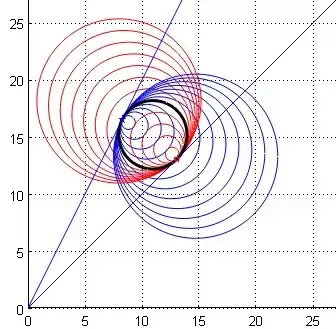
Fig. 1: (Some circles of) the pencil of circles $P_1$ in blue, and $P_2$ in red (notations of (1)). Their common circle, the one we want, is in black. Point-circles $(x_1,y_1)$ and $(x_2,y_2)$ are materialized by small stars.
I understand your method in the following way. You consider two linear pencils of circles each one generated by a "point-circle" [...] and a straight line:
$$\begin{cases}[(x-x_1)^2+(y-y_1)^2]+L(y-2x)&=&0&\text{pencil} \ P_1\\
[(x-x_2)^2+(y-y_2)^2]+M(y-x)&=&0&\text{pencil} \ P_2\end{cases} \tag{1}$$
and you want to find the common circle to the two pencils ; the problem you meet is that, by identification of like coefficients,
$$\begin{cases}x_1 + L&=&x_2+\frac{M}{2}\\y_1 - \frac{L}{2}&=&y_2 - \frac{M}{2}\\x_1^2 + y_1^2&=&x_2^2 + y_2^2\end{cases}\tag{2}$$
you have 3 equations with 6 unknowns...
In fact you should use only 4 unknowns because $y_1=2x_1$ and $y_2=x_2$.
Moreover you haven't used the fact that the radius is $3$ ; this can be done by expressing that the center of the circle whose coordinates are "visibly" $(x_1+L,y_1-\frac{L}{2})=(x_1+L,2x_1-\frac{L}{2})$ is at distance $3$ from $(x_1,y_1)=(x_1,2x_1)$ ; this condition is expressed by
$$L^2+\frac{L^2}{4}=3^2 \ \implies \ L=\dfrac{6}{\sqrt{5}}\tag{3}$$
(The plus sign has been chosen in order to have the center of the circle under the line with equation $y=2x$ ; we could have as well chosen to determine $M=-3\sqrt{2}$).
$L$ being known, system (2) is reduced to 3 simple equations with 3 unknowns.
In this way your method is fully viable.
Remark: the third equation in (2) expresses the equality of the lengths of the tangents $OT_1$ and $OT_2$ issued from the origin.
Here is a different way. Let $C=(x_0,y_0)$ be the center of the circle.
The different constraints of distances can be encapsulated into the double equation (see here):
$$\underbrace{\dfrac{1}{\sqrt{2}}(y_0-x_0)}_{\text{distance from C to line } y-x=0}=\underbrace{\dfrac{1}{\sqrt{5}}(2x_0-y_0)}_{\text{distance from C to line } y-2x=0} \ = \ \ 3$$
whose solution is
$$x_0=3(\sqrt{2}+\sqrt{5}), \ \ y_0=3(2\sqrt{2}+\sqrt{5})$$
Therefore, the equation of your circle is:
$$(x-x_0)^2+(y-y_0)^2=3^2$$
that can be somewhat simplified if you expand the squares.
